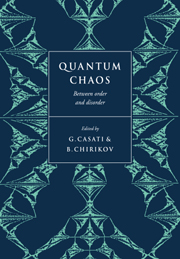Book contents
- Frontmatter
- Contents
- Preface
- Acknowledgments
- Introduction
- Part One Classical chaos and quantum localization
- Stochastic behaviour of a quantum pendulum under a periodic perturbation
- Quantum dynamics of a nonintegrable system
- Excitation of molecular rotation by periodic microwave pulses. A testing ground for Anderson localization
- Localization of diffusive excitation in multi-level systems
- Classical and quantum chaos for a kicked top
- Self-similarity in quantum dynamics
- Time irreversibility of classically chaotic quantum dynamics
- Effect of noise on time-dependent quantum chaos
- Dynamical localization, dissipation and noise
- Maximum entropy models and quantum transmssion in disordered systems
- Solid state “atoms” in intense oscillating fields
- Part Two Atoms in strong fields
- Part Three Semiclassical approximations
- Part Four Level statistics and random matrix theory
- Index
Effect of noise on time-dependent quantum chaos
Published online by Cambridge University Press: 07 May 2010
- Frontmatter
- Contents
- Preface
- Acknowledgments
- Introduction
- Part One Classical chaos and quantum localization
- Stochastic behaviour of a quantum pendulum under a periodic perturbation
- Quantum dynamics of a nonintegrable system
- Excitation of molecular rotation by periodic microwave pulses. A testing ground for Anderson localization
- Localization of diffusive excitation in multi-level systems
- Classical and quantum chaos for a kicked top
- Self-similarity in quantum dynamics
- Time irreversibility of classically chaotic quantum dynamics
- Effect of noise on time-dependent quantum chaos
- Dynamical localization, dissipation and noise
- Maximum entropy models and quantum transmssion in disordered systems
- Solid state “atoms” in intense oscillating fields
- Part Two Atoms in strong fields
- Part Three Semiclassical approximations
- Part Four Level statistics and random matrix theory
- Index
Summary
The dynamics of a time-dependent quantum system can be qualitatively different from that of its classical counterpart when the latter is chaotic. It is shown that small noise can strongly alter this situation.
What is the nature of a quantum system whose classical counterpart exhibits chaotic dynamics? The subfield dealing with this question has been called quantum chaos. A striking result in quantum chaos has been obtained by Casati et al. These authors considered a particular Hamiltonian and a potential representing periodic impulses kicking the system. If the strength of the kicks is large enough, then, in the classical description the motion is chaotic, and the momentum variable, p, behaves diffusively. That is, the average value of p2 apparently increases linearly with time. Casati et al. considered numerically the quantum mechanical version of the same problem with ħ small. They found that for early times, the average value of p2 increased linearly with time at roughly the classical diffusive rate, but that for long time this linear increase slowed and eventually appeared to cease. Thus, there was no numerically discernible diffusion in the quantum case.
The observed saturation of the growth of 〈p2〉 is understandable if the Schrödinger operator for this problem has an essentially discrete quasienergy level spectrum. Recently, Fishman, Grempel, and Prange have presented strong arguments supporting the idea that the quasienergy spectra for systems of the type studied by Casati et al. are essentially discrete. These arguments are based on an analogy with Anderson localization of an electron in a solid with a random lattice.
Information
- Type
- Chapter
- Information
- Quantum ChaosBetween Order and Disorder, pp. 157 - 160Publisher: Cambridge University PressPrint publication year: 1995
